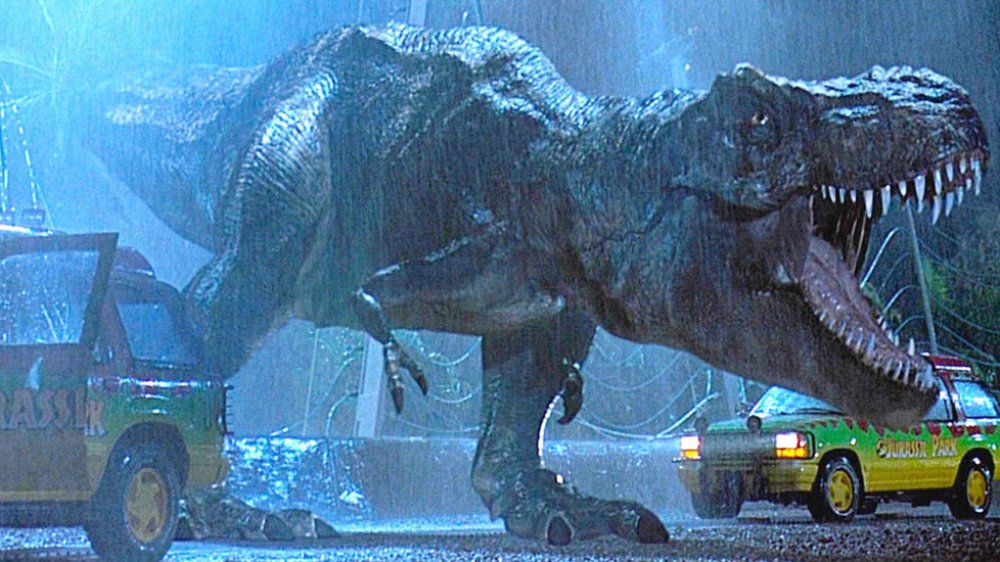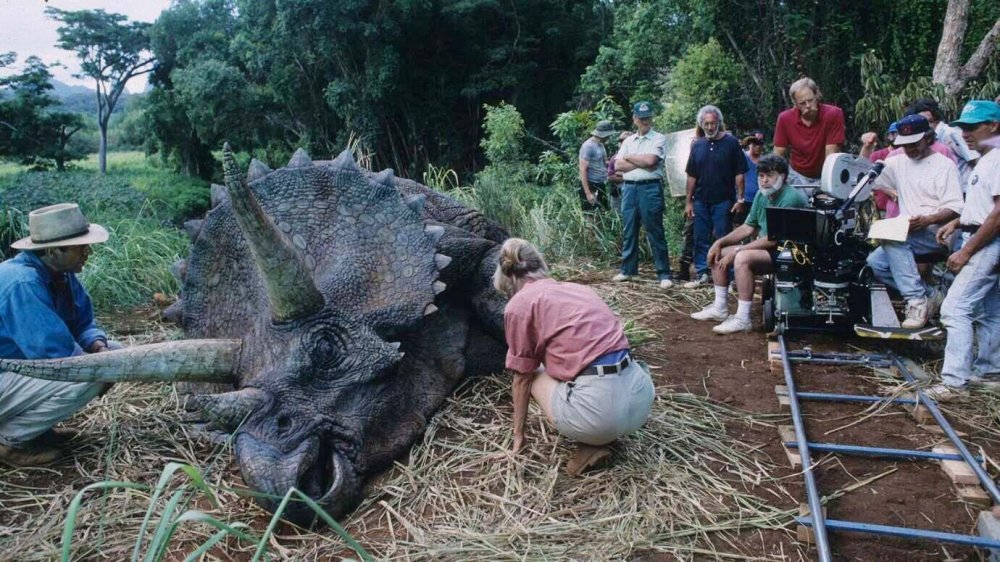Why This Awesome T-Rex Scene Was Cut From Jurassic Park
The T-Rex attack scene in 1993's Jurassic Park is absolutely epic — but another, equally nail-biting scene involving the big fella failed to make the cut.
Jurassic Park screenwriter David Koepp has been making the promo rounds ahead of the release of his new movie, the Kevin Bacon-starring psychological thriller You Should Have Left. With a filmography as extensive as his, he's found himself fielding a lot of questions about some of the iconic films he's been a part of. In a appearance on CinemaBlend's ReelBlend podcast, Koepp revealed that one T-Rex-centric scene in Jurassic Park — which was featured in Michael Crichton's novel and included in the original screenplay — was shot down early by director Steven Spielberg.
The scene would have been a doozy: It apparently would have taken place in the daytime (in contrast with the Jeep attack scene, which occurs during a dark and stormy night), and would have ramped up the suspense before hitting viewers with a startling burst of action. In the scrapped scene, Dr. Alan Grant (Sam Neill) – accompanied by the kids, Lex (Ariana Richards) and Tim (Joseph Mazzello) — are trying to make their way back to the Visitor Center the morning after the initial T-Rex onslaught. They encounter the beast once again, but manage to sneak past it to the raft corral, where they commandeer a raft and head down the river.
Unfortunately, T-Rex notices, and slips into the water to pursue the raft. It submerges completely, and the trio prepare for the worst — and they get it, as the dinosaur comes bursting out of the water to attack the raft. Grant and the children narrowly manage to escape by maneuvering the raft through a cluster of big trees, and T-Rex gives up the chase.
The entire scene was not only scripted, but also storyboarded. (You can check out how the sequence might have looked on the Jurassic Time YouTube channel.) According to Koepp, Spielberg passed on shooting the scene for one reason: the fact that water was involved.
Why did Steven Spielberg decide to cut the raft scene?
Shooting Jurassic Park with a production budget of $63 million that's pretty measly for the scale and scope of the movie presented many technical challenges for Spielberg and his VFX crew, which they overcame in a number of ways. The T-Rex Jeep attack, for example, was achieved by expertly combining animatronics with CGI and obscuring much of the action in the darkness and rain. Koepp told ReelBlend that for Spielberg, shooting a daytime, water-based action sequence featuring the T-Rex was a bridge too far — thanks to his famously frustrating experience filming his classic breakthrough feature, Jaws.
"[Spielberg] was showing me a bunch of [storyboards] he'd done, some of which were more or less exactly as you see them in the movie," Koepp remembered. "There was a sequence with the river and the Rex and the kids. But he thumbs past it and said, 'Oh, we're not gonna do this.' It was cut very early on. There was so much that was going to be challenging and difficult, and had yet to be figured out technologically in that movie. The idea of adding water to that made Mr. Jaws [balk] ... It was gonna be hard enough."
That's certainly understandable. Jaws was the film that launched Spielberg's career, but if it hadn't been a smash hit, it could just as easily have ended it prematurely. Malfunctioning animatronics and the difficulties involved in shooting in the actual ocean nearly sunk (pun intended) the movie's now-legendarily difficult shoot, and it's easy to see how the mere notion of dealing with yet another animatronic beast stalking hapless humans in the water might have given Spielberg nightmares.
At the end of the day, the scene wasn't a make-or-break for Jurassic Park, which became an immortal classic and spawned a franchise that continues to this day. Much of the original movie's cast — including Neill and co-stars Laura Dern and Jeff Goldblum — will be returning for the sixth overall installment, Jurassic World: Dominion, currently set for release on June 11, 2021.

